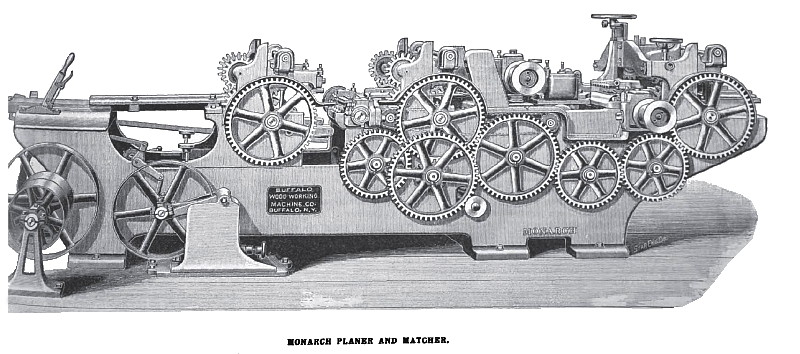|
Title: |
1894 Article-Buffalo Woodworking Machine Co., Monarch Planer |
|
Source: |
The Woodworker, 1894. |
|
Insert Date: |
10/13/2016 4:46:41 PM |
MONARCH PLANER AND MATCHER.
This machine, which works four sides, 10, 14 and 26 inches wide, has been especially designed for working hard woods and southern pine. It embraces many new features in its construction, the most important of which consists in the means employed to make the first cutting cylinder accessible and to bring the lumber to a thickness before It reaches the upper cylinder. This is accomplished by placing the first pair of entering rolls on a pedestal. This pedestal is made lo slide backward and forward on the frame of the machine by means or rack and pinion adjustment. The cut shows the pedestal moved away from the under cylinder leaving the cylinder fully exposed for adjusting or sharpening the knives. Practical planing mill men will recognize the value of this improvement. The lumber is all brought to a thickness by the first cylinder. This is accomplished by making the under feeding-in roll and the pressure-bar flexible, each having an independent pressure. Provision is made for as heavy s cut as one inch.
The top roll and pressure-bar are made rigid, and anything that passes through must come out of uniform thickness, thereby leaving very little tor the upper cylinder to do, and insuring better and more rapid work. It is also found that, owing to the fact that the under cylinder ls doing the heaviest cutting on the poorest side of the lumber, the face side is not as liable to show defects as when the upper cylinder does the heaviest cutting; in other words, if a board showing a No. 1 face should he put through a machine using the upper cylinder to bring it to a thickness, defects might show that would make a No. 2 of it. This cannot occur on this machine, as it leaves less than 1/16-inch for the upper cylinder to clean up on. This also permits it to run the chip-breaker closer to the knives of the upper cylinder, thereby doing smoother work.
The cylinders are made iron: solid crucible steel forgings and are slotted on four sides. The pulleys have a taper fit and are forced in place under powerful pressure, then finished on the cylinder. This insures a pulley that will always remain in balance. The upper cylinder has bearings 2½ inches in diameter, nine inches long; under cylinder 2¼ inches in diameter, nine inches long. The matcher spindles are two inches in diameter, carrying pulleys four inches in diameter. F. H. Crafts‘ patent journal box is used to carry these bearings. There are lighteners on both the matcher and cylinder belts. The belts are made endless and all slack is taken up by the tighteners, tension being regulated thereby to suit the character of the work being done. To explain this more intelligibly: if a thick board should enter the machine, instead of slacking up on the teed belt, tighten up on the cylinder belt. This keeps up the momentum of the cylinder until the thick board leaves the machine; then the operator is supposed to reduce the tension of the belt by dropping down the tightener a little. The matcher belts are also provided with tlghteners, and the tension of these belts can he regulated to suit the character of the work being done.
The pressure-plate over under cylinder is patented, the patentable feature being the position in which the ribs on the her are placed. Then ribs are placed diagonally, thus preventing creasing of lumber. This plate is also made hollow. Diagonal holes are drilled and connections made with a fan. When the machine is in motion the hollow space is filled with air, which escapes through the diagonal holes, blowing all chips and dust from the lumber, leaving it clean and bright.
The end chase of the cylinders is taken out by a brass plug located in the center of the box. There are three grooves turned in the center of the cylinder journals. The brass plug is accurately fitted to these grooves. When it becomes necessary to take out the end chase the brass plug is forced down into the grooves and held in place by a set-screw. When the machine is used for plain surface work, the plug is raised out of the grooves, thus giving the cylinders a slight end play, which insures more perfect lubrication and less danger oi cutting the boxes if dirt should get in them.
This machine ls also provided with F. C. Crafts’ patent chip-breaker, patent pressure-bar, patent loose pulley and other new features for which patents are pending. It is made by the Buffalo Wood-Working Machine Co., corner Seventh and Hudson Streets, Buffalo, N. Y.
Article & image courtesy of Daniel Warner. |
|
 1894 Buffalo Woodworking Machine Co., Monarch Planer
1894 Buffalo Woodworking Machine Co., Monarch Planer
|
|